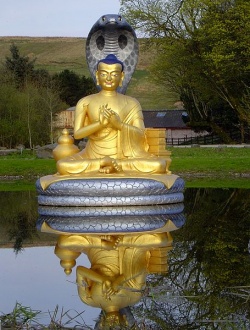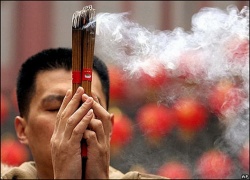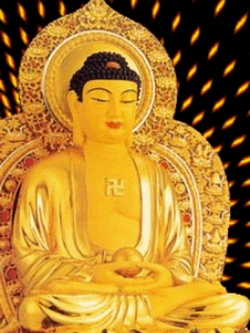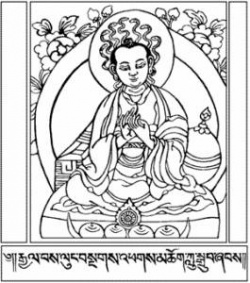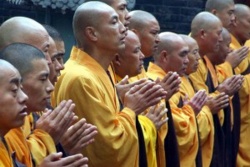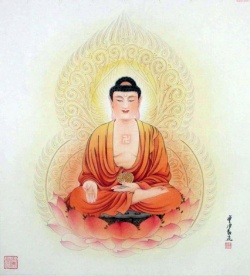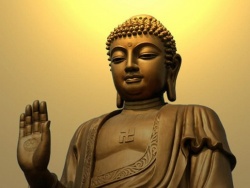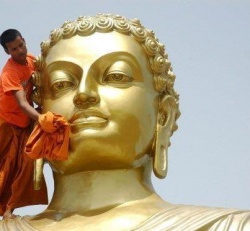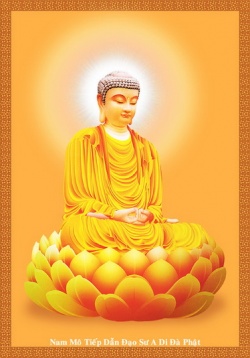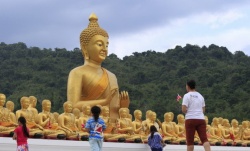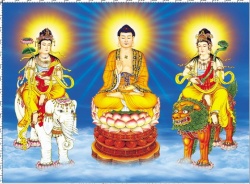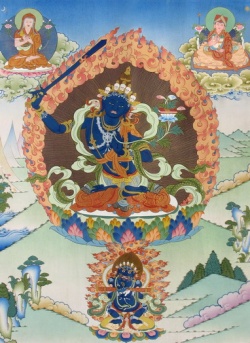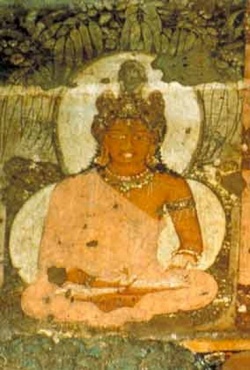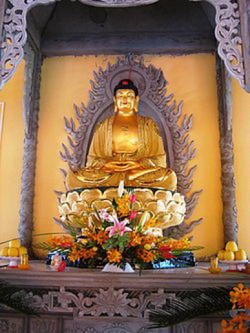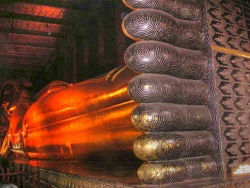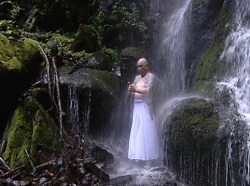Mahaprajnaparamita Sastra
The Mahaprajnaparamita Sutra was an encyclopedic collection of Prajnaparamita texts, usually attributed to Nagarjuna, translated into Chinese by Xuanzang and his assistants.[1] Alternatively, this name refers to the Large Sutra on the Perfection of Wisdom (Skt. Pancavimsatisahasrika-prajnaparamita-sutra]], meaning 25,000-Line Perfection of Wisdom Sutra) (Chinese: 摩訶般若波羅蜜多經; pinyin: Móhē Bōrě Bōluómìduō Jīng, whence the name Mahaprajnaparamita Sutra)
Selections from Nagarjuna’s Treatise on The Great Perfection of Wisdom (Skt. Mahaprajnaparamita-shastra; Jp. Daichido-ron
Composed by Nagarjuna Bodhisattva
Chinese Translation by Yiao Chin Tripitaka Master Kumarajiva
English Translation by Ben Yong Shr
There is a most wonderful country near the Himalayas,
abundant with joy and various treasures called Kosala.
The solar race, the sons of the Sakyas is where I was born. My heart renouncing aging, sickness and death, I left home seeking the way of the Buddhas.
The power of impermanence is very great, ignorant or wise, poor or wealthy,having attained the path or not yet attained the path, all are unable to avoid it!
Not by clever speech or wonderful treasures, not by deceit or argument, Like a fire incinerating 10 000 things, is the characteristic of impermanence.
As the sunlight illuminates all equally, flowers mature and open.
If the flowers are not yet mature, they should not be forced to blossom.
The Buddha is the same, preaching the Dharma with an equal mind.
Those with wholesome roots are matured, those not yet mature do not open.
Worldly knowledge other than Dharma, is no different from brute animals.
Seeking correct knowledge of the way, one is liberated from old age and death and enters Nirvana!
Inferior people seek purity with the eye; this is the false path of ignorance.
Their hearts are full off bonds and defilements, how can the eye see the pure way?
If the eye can see the pure way, what is the use of the treasure of wisdom and virtue?
There is no such thing as seeking purity with the eye; purity is by wisdom and virtue.
——————————————
Selections from Nagarjuna’s Treatise on The Great Perfection of Wisdom
Translated by Bhiksu Dharmamitra.
(Mahaapraj~naapaaramitaa Upadesha]]) is an immense exegesis to the Mahaapraj~naapaaramitaa Sutra in 25,000 lines. Classically, it is preserved only in a 100-fascicle Chinese edition translated from Sanskrit in 405c.e. by Kumarajiva, the brilliant and prolific translator-monk who was the premier transmitter to the Chinese of the Maadhyamika teachings of Nagarjuna. Although presented in the form of an exegesis, it is actually a compendium of Dharma jewels as interpreted by one of the most illustrious Indian masters of the Middle Way. All material is rendered directly from the Chinese (Taisho).
CODE KEY
•A = Analogies, Similes, Metaphors
•D = Dharma Discussions
•L = Lists Explained
•S = Stories (Usually illustrating concepts)
•T = Terms Explained
•V = Verses (Usually in summation or praise of concepts)
From Fasicle 006
The Ten Similes
(T25.101c6-105c18 [fasc.6])
Sutra: They understood all dharmas as being like a [magically- conjured] illusion, like a mirage, like the moon reflected in water, like empty space, like an echo, like the city of the Gandharvas, like a dream, like a shadow, like an image in a mirror, and like a [[[supernatural]]] transformation.
Upadesha: These ten similes are set forth for the sake of explaining [the nature of] empty dharmas. Like a Magically- conjured Illusion]
Question: If all dharmas are like a magically- conjured illusion, why is it then that dharmas have that by which they can be viewed, heard, smelled, tasted, touched, and that by which they can be objects of awareness? If it were actually the case that nothing whatsoever existed, it should not be the case that [[[dharmas]]] have “that by which they can be viewed” and so forth until we come to “that by which they can be objects of awareness.” Furthermore, if they are nonexistent and we thus only see them as a function of erroneous perception, why then don’t we see sounds and hear [[[visual]]] forms? If [[[dharmas]]] are all equally empty and nonexistent, why is it that there are those which can be perceived and those which cannot be perceived? If it were the case that “all dharmas are empty” [as you claim], then it should be that for any given finger, an extra fingernail would be nonexistent in just the same manner as the original fingernail is “nonexistent.” Why then don’t we see a second fingernail [on any of our fingers]? [In fact], we only see the original fingernail. Because of this fact, we know that it is because the original fingernail actually is existent that it can be seen, whereas it is because an extra fingernail is actually nonexistent that it can not be seen.
Reply: Although the characteristics of dharmas are empty, still, there is discrimination [which distinguishes] that which may be perceived and that which cannot be perceived. For example, although one may know that magically- conjured illusions of elephants, horses and other such phenomena are unreal, still, their forms may be seen, their sounds may be heard, and they may manifest in corresponding opposition to the six sense faculties without there being any error or confusion in that regard. This situation is the same with respect to dharmas. This is as referred to in The Virtuous Woman Scripture (Theriisuutra):
Virtuous Woman addressed the Buddha, inquiring, “World Honored One, does ignorance exist internally or not?” The Buddha replied, “No.” “Does it exist externally or not?” The Buddha replied, “No.” “Does it exist [both] internally and externally, or not?” The Buddha replied, “No.” “World Honored One, does this ignorance come forth [into the present] from the past, or not?” The Buddha replied, “No.” “Does it proceed from the present on to the future or not?” The Buddha replied, “No.” “Does this ignorance have that which is produced and that which is destroyed or not?” The Buddha replied, “No.” “Is there or is there not a dharma with a fixed and actual nature [of which we may say], ‘This is ignorance?’” The Buddha replied, “No.” At that time Virtuous Woman again addressed the Buddha, asking, “If it is the case that ignorance does not exist internally, does not exist externally, also does not exist both internally and externally, does not come into the present from the past, does not proceed into the future from the present, and is devoid of a true and actual nature, how can it be that there is a conditioning of ‘action’ arising from ‘ignorance,’ and so forth until we come to the accumulation of a multitude of sufferings? World Honored One, it is as if there were a tree. If it were the case that it had no roots, how could it succeed in putting forth a trunk, limbs, branches, leaves, flowers and fruit?” The Buddha replied, “Although the marks of all dharmas are empty, because the foolish common person has not learned this and because he has no wisdom, he thereby, in the midst of [[[empty]] dharmas], generates all manner of afflictions. Afflictions causally condition the creation of physical, verbal and mental karmic deeds. Karmic activity causally conditions the creation of a later bodily incarnation. The [possession of a] body causally conditions the undergoing of suffering and the experiencing of pleasure. [However], there is not herein any actual creation of afflictions. Also, there are no physical, verbal or mental deeds. Additionally, there is no one who undergoes suffering or bliss. This is analogous to a magician producing magically- conjured illusions of all manner of phenomena. What do you think? As for that which is created through magically- conjured illusions, is it internally existent, or not?” She replied, “It is not.” “Is it externally existent?” She replied, “It is not.” “Is it both internally and externally existent?”
She replied, “It is not.” “Does it or does it not come from the past into the present or proceed from the present on into the future?” She replied, “It does not.” “Within that magically- conjured illusion, is there or is there not anything which is produced or which is destroyed?” She replied, “There is not.” “Is there or is there not actually any single dharma which is created by this magically- conjured illusion?” She replied, “There is not.” The Buddha asked, “In a magically- conjured illusion of a musical performance, do you or do you not see anything or hear anything?” She replied, “I both hear things and see things.” The Buddha asked Virtuous Woman, “If a magically- conjured illusion is empty, deceptive and devoid of reality, how is it that there is able to be the creation of a musical performance from within the magically- conjured illusion?” Virtuous Woman addressed the Buddha, saying, “World Honored One, “The characteristics of magically- conjured illusions are just this way. Although they are devoid of any basis, still they can be heard and seen.” The Buddha said, “Ignorance is just the same as this. Although it is not internally existent, is not externally existent, is not both internally and externally existent, does not come into the present from the past, does not proceed forth from the present on into the future, is devoid of an actual nature, and is devoid of that which is produced and that which is destroyed, still, ignorance causally conditions the creation of actions and so forth until we come to [[[causally]] conditions] the accumulation of a multitude of sufferings. And just as when a magically- conjured illusion ceases, that which is summoned forth by that magically- conjured illusion also ceases, so too it is in the case of ignorance. When ignorance is brought to an end, actions are also brought to an end and so forth until we come to the accumulation of a multitude of sufferings is also brought to an end.” Additionally, this simile of a magically- conjured illusion serves to demonstrate to beings that all conditioned dharmas are insubstantial. It is as if to say that all actions are like a magically- conjured illusion which deceives little children. They belong to the sphere of causes and conditions. They are not inherently existent and they do not endure for long. Therefore it states here that all the bodhisattvas are aware of all dharmas as being like a magically- conjured illusion. [Like a Mirage] As for [the simile] “like a mirage…,” a mirageappears on account of sunlight and the moving about of the dust by the wind. In the midst of a vast wilderness, this phenomenon may resemble “wild horses.” On first observing it, an unknowledgable person may think that it is water.
The features characteristic of manhood or womanhood are also like this. The sunlight of the fetters and afflictions heats up the dusts of karmic formations. The wind of improper reflective thought blows about in the vast wilderness of transmigration. One who is devoid of wisdom looks upon a given set of characteristics as constituting manhood or womanhood. It is [[[phenomena]] such as] these which are referred to as being like a mirage. Furthermore, if one sees a mirage from a distance one may think that it is water. However, if one draws closer, there is no perception of water. [The situation of] a person lacking in wisdom is also like this. If he is distant from the Dharma of the sages, he is not aware of the nonexistence of self, is not aware of the emptiness of dharmas, and, in the midst of the intrinsically empty dharmas of the aggregates, sense realms and sense fields, he engenders [in his thoughts] characteristics of personhood, characteristics of manhood, and characteristics of womanhood. But, if he draws near to the Dharma of the sages, then he becomes aware of the actual mark of all dharmas. At this time all of the various kinds of false and deceptive erroneous thought are entirely eliminated. It is on account of this that it states here that the bodhisattvas are aware of all dharmas as being like a mirage. [Like the Moon {reflected} in the Water] As for [the simile] “Like the moon [reflected] in the water”, the moon actually resides in space whereas its reflection appears in the water. The moon of the mark of actual Dharma resides in the empty space of the reality limit and the nature of the dharma of suchness, however in the water of the minds of the common gods and men, there appears the mark of a self and that which belongs to a self. Because of this, they are referred to as being like the moon [reflected in] the water. Then again, this situation is like that of a small child who sees the moon in the water, is delighted thereby, and then desires to sieze hold of it. Adults observe this and then laugh. People who are lacking in wisdom are just like this. On account of entertaining the view of the body [as the basis of individuality], they [erroneously] discern the existence of a self. Because they are lacking in actual wisdom, they perceive all manner of dharmas and having perceived them, they take delight in them and desire to grasp at the various characteristics: the characteristics of manhood, the characteristics of womanhood, and so forth. But the sages who have gained the Way laugh at this. This is as described in a verse:
Just like the moon in water or the waters of a mirage, Obtaining wealth within a dream, seeking life in the midst of death. So there are men who truly do aspire herein for gains. Delusions of such people do bring forth the sage’s smile. Furthermore, just as when one sees the reflection of the moon in still water, but, when that water is roiled, one no longer sees it, so too, though one may view the reflection of a self, arrogance and the fetters in the stagnant water of ignorance- laden thought, if one roils those mental waters with the staff of actual wisdom, one no longer sees reflections of a self and other such fetters. It is on account of this that it states here that the bodhisattvas are aware of all dharmas as being like the moon reflected in the water. [Like Space] As for [the simile] “like space,” this refers to merely possessing a name while being devoid of any actual dharma. Space, is not a visible dharma. On account of being observed from a great distance, the visible light alters [its appearance] so that one sees a light blue color. All dharmas are just like this. They are empty and devoid of anything which exists. On account of being distant from the actual wisdom of the non- outflow state, one foresakes the actual mark [of dharmas] and perceives the existence of others, a self, men, women, houses, cities, suburbs and all manner of other various phenomena. The mind attaches to them just a a small child in looking up at a clear sky thinks that there is an actual form there. There have been people who have flown to extremely high altitudes and yet have not observed anything whatsoever there. It is on account of observing from a great distance that one is of the opinion that [[[space]]] is blue in color. All dharmas are just like this. It is because of this that it is stated that they are like space. Alternatively, [one might say that] they are like space in the sense of being eternally pure. People are of the opinion that a murky cover of clouds is impure. The situation with regard to dharmas is just like this. Although they are always pure in nature, on account of the dark haze of sensual desire, aversion, and so forth, people come to regard them as impure. This circumstance is described in a verse: As when the summer skies are thundrous, flashing and torrential, The dark clouds and engulfing mists are fouled with the impure, The common man devoid of wisdom is also just like this:
All manner of afflictions always cover up his mind. As in the days of winter when the sun comes forth at times, But usually is obscured by the clouds of turbid vapors, Although one’s gained the first fruition or has reached the second path, He still is covered over by defilement of desires. As in the springtime when the sun attempts its brilliant shining, But still it is obscured at times, enveiled by shadowy clouds, Though at the third fruitionone has left desire’s defilement, Still, ignorance and arrogance, mere traces, veil the mind. As on an autumn day no clouds encroach and hide the sun, And as the great sea’s waters when beheld are seen as clear, His mind has done the [[[sages]]'] work and reached no outflows’ realm. The arhat has attained a state of purity like this. Additionally, space has no beginning, nothing in between and no end. Dharmas are the same in this respect. Moreover, this is just as the Buddha declared to Subhuuti in The Mahaayaana, “Space has no past time, no intervening time, and no future time. Dharmas are also this way.” That scripture will be discussed extensively herein. For these reasons, it is said that dharmas are like space.
Question: Space is an actually existent dharma. How is this so? If it were the case that space is devoid of any actual dharma, then, whether [we speak of] raising or lowering, coming forth or going away, retracting or extending, going out or coming in, or any other circumstance wherein something is done, there ought to be nothing [which could be done at all] as there would be no place in which to move.
Reply: If space were an actually- existent dharma, space ought to have a location in which it resides. How so? If there were no place in which it resided, then there would be no dharma. If it were the case that space resided in openings, then this would be a case of space residing in the midst of space. On account of this, it should not be the case that space resides in openings. If one holds that [[[space]]] resides in that which is solid, because this solid entity is non- space, [[[space]]] cannot reside in it, as [that which is solid] can’t take anything in. Moreover, you say that the place in which [[[space]]] resides is just space [itself]. But [[[space]]] is analogous to a rock cliff which, within its solidity, has no place for anything to reside. If it has no place in which it resides, then there is no space. Because space has no place in which it resides, there is no space. Then again, because there is no characteristic, there is no space. Each and every dharma has characteristics. It is on account of the existence of characteristics that we know there exists a given a dharma. For example, earth is characterized by solidity, water is characterized by moisture, fire is characterized by heat, wind is characterized by movement, consciousness is characterized by awareness, wisdom is characterized by understanding, the world is characterized by production and extinction [i.e. birth and death], and nirva is characterized by eternal extinction. Because this space is devoid of characteristics, it is nonexistent.
Question: Space does possess characteristics. Because you are unaware of this you claim that it is nonexistent. Absence of form is the characteristic of space.
Reply: This is not so. Absence of form indicates only separateness among forms and there is no other [additional] dharma indicated thereby. This is analogous to [the situation which obtains] when a lamp goes out. There is no additional dharma [in that case either]. Because of this, there is no characteristic [indicative] of space. Moreover, [there is another reason that one can say that] this dharma of space is nonexistent. How so? It is because of form that you hold that the absence of form is the characteristic of space. If that were the case, then prior to the production of form, there is no characteristic of space. Additionally, you maintain that form is an impermanent dharma whereas space is a permanent dharma. [If this were the case], then it ought to be that prior to the existence of form there was a previously- existent dharma of space since it is [supposedly] a permanent dharma. But if form was not yet existent, then there would not have been [at that time] any such [contrasting and defining] “absence of form.” If there were no “absence of form,” then there would have been no characteristic [indicating the supposed existence] of space. If there is no characteristic, then there is no dharma. Because of this, [one should know that] space only possesses a name and is devoid of any reality. As it is with space, so too it is with dharmas. They only possess a false name but are devoid of reality. It is on account of this that the bodhisattvas are aware of all dharmas as being like space. [Like an Echo] As for [the simile] “like an echo,” it is just as when one is in a narrow valley in the deep mountains, or as when one is in a deep and precipitous ravine, or as when one is in a large, empty building. Whether it be one’s voice or the sound of striking something, there is [another] sound which arises from the given sound which we then refer to as an “echo.” A person who is unknowledgeable about this will be of the opinion that [the echo] is [some other] person’s voice. However, one who is wise will think, “This sound was not created by anyone. It was merely on account of the sounds contacting [a barrier] that there then arose another sound which we refer to as an ‘echo.’” The phenomenon of echoes is “empty” but is able to deceive the faculty of hearing. This is analogous to the [process which occurs] when a person is about to speak. The air in the oral cavity which we refer to as udna goes back [down the windpipe] and when it reaches the diaphragm, having contacted the diaphragm, an echoing sound then comes forth. When the echoing sound comes forth, it may encounter and return from seven different locations. It is this which is referred to as the voice. This is as stated in verse:
Udaana is the name of breath.
It strikes the diaphragm, then ascends.
This breath contacts in seven places:
The neck, the gums, the teeth and lips,
The tongue, the throat, the chest as well.
Herein it is that voice is born.
The fool he fails to understand this,
Deludedly attached, he’s angry and stupid.
The Middle person, having wisdom,
Isn’t angry or attached,
And doesn’t take up stupid actions,
But just accords with dharmas’ marks.
In bending, straightening, flexing, extending,
In going, coming, issuing speech.
In all of this, there’s no one acting.
Is it magical conjuration?
Or mechanical wooden people?
Or the stuff that’s born of dreams?
Is “self” but warmth of energy pent up?
Does it exist or does it not*?
Just who is it that comprehends this?
This bony frame that’s bound with tendons
Is able to utter sounds of speech
Like molten iron thrown in water.
It is for these reasons [discussed above] that it is said that
the bodhisattvas are aware of all dharmas as being like an echo.
[Like the City of the Gandharvas]
As for [the simile] “like the city of the Gandharvas,” when the
sun first rises, one sees the city gates, the buildings, the
watchtowers, the palaces, and travellers leaving and entering. As the
sun rises higher, [the city] gradually disappears. One is only able to
perceive this city with the eyes and thus it is devoid of any reality.
This is what is meant by the city of the Gandharvas.
There once was a man who was at first unable to see the city of
the Gandharvas, but who, at dawn, looked towards the east and saw it.
He thought that there would actually be music there and thus set out
swiftly in search of it. As he grew progressively closer, it gradually
faded until, when the sun was high in the sky, it vanished altogether.
As he became hungry, thirsty and extremely discouraged, he gazed into
the distance and, seeing the heat waves as a mirage, thought that they
were a body of water, and then ran quickly to reach it. But as he grew
closer, it gradually disappeared. Exhausted and distressed, he reached
a narrow valley deep in the mountains and, yelling out and wailing, he
heard an echo and thought that there were people who lived there, sought
to find them and, utterly exhausted, still did not see anyone at all.
Then he thought it over and understood, whereupon his thoughts of
craving and yearning ceased.
People who are lacking in wisdom are just like this. Amidst the
empty aggregates, sense realms, and sense fields, they perceive the
existence of a self and the existence of dharmas. Through thoughts of
sensual desire and aversion they become attached and crazily run off in
the four directions, pursuing pleasure and becoming self- obsessed.
Through inverted views, they are deceived and deluded and bring
themselves to the most extreme degree of anguish. But if one employs
wisdom and thereby becomes aware of the nonexistence of a self and of
the nonexistence of actual dharmas, then at this time the yearning
arising from cognitive inversion ceases.
Moreover, the city of the Gandharvas is a non- city, but in
their thoughts, people imagine it to be a city. The common person is
also just like this. In that which is not a body, he imagines the
existence of a body. In that which is not a mind, he imagines the
existence of a mind.
Question: A single example would be sufficient for one to
understand [the concept]. Why employ more comparisons?
Reply: I have responded to this question earlier [in the text].
This Mahayana is like the waters of a great ocean. All dharmas are
entirely contained within it. Because of the many causes and conditions
associated with the Mahaayana, there is no fault in employing many
comparisons. Additionally, because the bodhisattvas are possessed of
extremely profound and keen wisdom, all manner of dharmic methods, all
manner of causes and conditions, and all manner of comparisons are
employed to demolish all dharmas. It is for the sake of facilitating a
person’s understanding that it is appropriate to draw extensively upon
comparisons.
Additionally, nowhere in the Dharma of the Hearers is there
found this “city of the Gandharvas” comparison. They do possess all
manner of other comparisons illustrative of impermanence: Form is like
a mass of foam; feelings are like bubbles; perceptions are like a
mirage; karmic formations are like the banana [[[tree]] trunk];
consciousness is like a magical conjuration or like a magically-
conjured “net.” In [this] sutra, comparisons are employed [to
demonstrate] emptiness. This “city of the Gandharvas” comparison is
used herein because it is different.
Question: In the Dharma of the Hearers, a city is employed as a
simile for the body. Why then is this “city of the Gandharvas” simile
used here?
Reply: In the Dharma of the Hearers, that simile of the city
[leaves intact] the multitude of conditions as actually existent. [In
that simile], only the “city” itself is [intended to be shown as] a
false appellation. [However, in this simile here of] the city of the
Gandharvas, the multitude of conditions themselves are also [intended to
be shown as] nonexistent. They are like a “wheel” created by a whirling
firebrand which only [seems to exist by] deceiving a man’s eyes. In the
Dharma of the Hearers, the city is employed as a simile for the sake of
demolishing [the concept of] a “self.” Herein, it is because the sharp
faculties of the bodhisattvas have [allowed them] to enter deeply into
the emptiness of all dharmas that the city of the Gandharvas is employed
as a simile.
For these reasons, it states that [all dharmas are] like the
city of the Gandharvas.
[Like a Dream]
As for [the simile] “like a dream,” it is just as in a dream
wherein there is nothing whatsoever which is real and yet we believe
that there is something which is real. Upon awakening we realize that
there was nothing at all and then, ironically, laugh at ourselves. So
too it is with people. In the slumber of the fetters, although reality
is nonexistent, still, they become attached. When they gain the Way
they then become aware that there is nothing which is real and then
laugh at themselves. It is because of this that it says “like a dream.”
Then again, as for dreams, it is on account of the power of
sleep that even though there are no dharmas, one nonetheless perceives
them. People are just like this. It is on account of the power of the
sleep of ignorance that, [in the midst of] all manner of [[[phenomena]]
which] do not exist, we nonetheless perceive them to exist: the so-
called “self”, “that which belongs to the self,” “manhood,” “womanhood,”
and so forth.
Moreover, just as in a dream, wherein although there is nothing
to be joyful about and yet one is joyful, there is nothing to be hateful
about and yet one is hateful, and there is nothing to be frightened
about and yet one is frightened, so too it is with the beings who
inhabit the three realms. On account of the slumber of ignorance, even
though they ought not to be hateful, still they are hateful, even though
they ought not to be joyful, still they are joyful, and even though they
ought not to be frightened, still they are frightened.
Additionally, there are five kinds of dreams: Where one’s
physical health is out of balance, if heat energy is excessive then one
tends more often to dream of seeing fire or seeing yellow or seeing red.
If cold energy is excessive then one tends more often to see water or to
see whiteness. If wind energy is excessive then one tends more often to
see flying [[[phenomena]]] or to see blackness. Also, on account of more
often thinking about and remembering that which one has heard or seen,
one then sees [those very same matters] in dreams. Or perhaps a deva
bestows a dream wishing to cause one to become aware of a forthcoming
event. In all of these five kinds of dreams, there is nothing which is
real and yet we erroneously view [such phenomena].
People are just the same as this. On account of the causes and
conditions deriving from the power of “the [false] view of
individuality”, the beings of the five paths of rebirth may perceive the
existence of four types of “self”: “The form aggregate is my self”;
“form is the location of my self”; “form is contained within my self”;
or “my self is contained within form.” Just as this is the case with
form, so too it may be with feelings, perceptions, karmic formations, or
consciousness, so that [when these] four [subsidiary views are
correlated with each of these] five [[[aggregates]]], twenty [possible
subsidiary views may result]. But when one gains the Way and
experiences the awakening of actual wisdom, one becomes aware that there
is nothing [in that dream] which is actual.
Question: One should not say that dreams are devoid of reality.
Why [not]? When the thought [arising from] consciousness encounters
[the appropriate] causes and conditions it then gives rise to
consciousness in the midst of a dream. There are all manner of
conditions. In the absence of these conditions, how would consciousness
be produced?
Reply: As for that which is nonexistent, although one should not
see it, one nonetheless sees it. In a dream one may see a person who
has horns on his head. Or perhaps, in a dream, one may see the body
flying through space. But in actuality, people have no horns, nor does
the body fly. Therefore [these dream experiences] are devoid of
reality.
Question: It is a fact that there are such things as human heads
and it is also a matter of fact that elsewhere there are horns. It is
on account of a mental deception that one sees a person with horns on
his head. It is a fact that space exists and it is also a fact that
there is such a thing as flying. It is on account of a mental deception
that one sees the body flying. It is not [therefore] the case that
[these dream experiences] are devoid of reality.
Reply: Although there actually do exist human heads and although
there actually do exist horns, nonetheless, [[[seeing]]] men’s heads which
have grown horns is a case of erroneous perception.
Question: The world is immense and the causes and conditions
[originating in] previous lifetimes are of all manner of different
types. It may be that there are other countries wherein there are
people whose heads have grown horns. Perhaps there are those who have
but one hand and one foot, or those who are only one foot tall, or those
who have nine heads. Why then should we consider it so strange for a
person to have horns?
Reply: Although it could be that there are people in another
country who have horns, still, when a person native to this country whom
one personally recognizes appears in a dream with horns on his head,
that [appearance] cannot be [explained through resort to such a
hypothesis]. Furthermore, when one sees in a dream a boundary to space,
an end to one of the directions, or a final point in time, how could
such a circumstance be possessed of any reality? Wherein is there a
place devoid of space, devoid of direction or devoid of time? It is on
account of these [points that we explain that phenomena seen] in dreams
are nonexistent and yet we still perceive them as existent.
You previously asked how it could be that, in the absence of
[actual] conditions, consciousness nonetheless arises. Although there
are no conditions corresponding to the five sense objects, still,
because of a process of transformation wrought by the power of one’s own
contemplation and remembrance, the condition of a dharma [as an object
of mind] may nonetheless arise. [For instance]: if a person [merely]
speaks of the existence of [someone with] two heads, one may, with that
statement as a cause, generate a [corresponding] thought. The fact
that, even though things in dreams are nonexistent, we nonetheless see
them as existent is just the same as this. So too it is with all
dharmas. Although all dharmas are nonexistent, still we are able to see
them, are able to hear them, and are able to be aware of them. This is
as described in a verse:
Like dreams, like magical conjurations,
Like [towns in which] gandharvas [dwell],
Just so with every single dharma:
They all are just the same as these.
It is for these reasons [discussed above] that it says that the
bodhisattvas are aware of all dharmas as being like a dream.
[Like a Shadow]
As for [the simile] “like a shadow”, a shadow is something which
can only be seen but which cannot be grasped. All dharmas are also just
like this. The eye and the other faculties are able to see, hear, be
aware of and cognize them, but they still cannot actually be gotten at.
This is as explained in a verse:
This wisdom which is actual,
It cannot from four sides be grasped.
It’s like an enormous conflagration
Which itself cannot be touched.
The dharmas cannot be accepted
And neither should they be accepted.
Moreover, just as with a shadow where when one shines a light it
manifests, but when one does not shine it it is nonexistent, when the
fetters and afflictions block the light of correct views there manifests
the shadow of the mark of a self and of the mark of dharmas.
Additionally, just as with a shadow where when a person goes,
[the shadow] goes, when a person moves, the [shadow] moves, and when a
person stops, the [shadow] stops, so to it is with the shadows of
wholesome and unwholesome karmic actions: when one moves on to a future
life, [the karmic shadows] also move along and when one abides in the
present life, [the karmic shadows] abide as well. Because the
retribution is not cut off, when offenses or merit ripen, then they come
forth. This is as explained in a verse:
Even in space it will chase along after.
And deep into mountains ‘midst boulders pursues.
To the depths of the earth it will follow behind us.
And will plunge into ocean’s [deep] waters as well.
It everywhere constantly follows, pursuing.
The shadow of actions will not go away.
It is on account of this that it says that all dharmas are like
a shadow. Furthermore, just as a shadow is empty and nonexistent such
that if one seeks for something actual in it one cannot succeed, so too
it is with all dharmas for they are empty and devoid of anything which
is actual.
Question: This matter of a shadow being empty and devoid of
anything which exists is not the case. How so? In the Abhidharma, it
says, “What is meant by the sense field of form? [It refers to] blue,
yellow, red, white, black, azure, purple, light, shadows, and so forth,
as well as the three kinds of created form associated with physical actions.”
This is what is meant by the sense field of visible form. How then can you say
that [shadows] are nonexistent?
Moreover, it is the case that shadows actually exist because
they are possessed of causes and conditions. [For example], the cause
may be a tree and the condition may be brightness. When these two
factors come together there is the creation of a shadow. How can you
say that they are nonexistent? If there are no shadows then it ought to
be the case that all other dharmas possessed of [corresponding] causes
and conditions are nonexistent as well.
Additionally, the form of these shadows can be seen. [This is
true of] their length, their size, their relative coarseness, and their
contours. When the shape itself moves, the shadow also moves. These
matters can all be seen. For these reasons, it should be that they are
[admitted as being] existent.
Reply: Shadows are truly empty and nonexistent. As for your
citation of explanations from the Abhidharma, these exegeses of the
meaning of the Abhidharma are explanations created by people. There are
particular dharmic access methods the intent of which people misapprend
and thus become attached to as being actual.
Take for instance the explanation of the Vibhaa.saa which holds
that infinitesimally minute fine particles cannot be broken up and
cannot be burned up. If this were the case then they would be eternally
existent. Additionally, with regard to dharmas of the three periods of
time, [it claims that] they reside in the future and come forth into the
present and that they move on from the present and go on into the past
and that in doing so nothing whatsoever is lost. If this were the case
then that would be a case of eternalism. Moreover, it says that all
conditioned dharmas undergo a [[[constant]]] process of [instantaneous] re-
production and re- extinction and do not abide at all. If this were the
case then it would be a sign of annihilationism. How so? Because they
previously existed and now do not exist. All manner of unorthodox
explanations such as these contradict the Buddha’s words. One may not
employ this as corroboration for [the view that] shadows [actually
exist].
Now these [shadows] are different from form dharmas. When form
dharmas are produced they must possess fragrance or flavor or
tangibility or some other [such characteristic]. Shadows then are not
like this and on this account are nonexistent. For instance, a vase is
cognizable through two of the faculties, namely the eye’s [[[visual]]]
faculty and the body’s [[[Wikipedia:tactile|tactile]]] faculty. If a shadow is existent then
it too should be cognized by two faculties. But there is no such case.
For these reasons, it is not the case that there exists any actual
phenomenon in shadows. They are only a dharma which deceives the eye.
They are unreal in just the same way as the “wheel” which one produces
by picking up a firebrand and whirling it rapidly around in a circle.
Shadows are nonexistent entities. If shadows were existent entities, it
ought to be that they could be broken or destroyed. [However], as long
as the form [which casts the shadow] remains undestroyed, the shadow is
never damaged. For this reason, [shadows] are empty. Additionally,
because shadows are directly associated with their forms they are not
inherently existent. They are therefore empty. Although they are
empty, the mind nonetheless generates an [associated] visual perception.
For these reasons, it says that all dharmas are like shadows.
[Like Images in a Mirror]
As for [the simile] “like images in a mirror,” [all dharmas] are
like images in a mirror [in the sense that] the images in a mirror are
not created by the mirror, are not created by the visage [which gazes
into it], are not created by the person who holds the mirror, are not
spontaneously produced, and are not [created] in the absence of
[corresponding] causes and conditions.
How is it that they are not created by the mirror? As long as
the visage has not yet presented itself before the mirror, there is no
[such] image. For this reason, it is not the case that the image is
created by the mirror.
How is it that they are not created by the countenance? In the
absence of a mirror there are no images.
How is it that it is not the case that the holder of the mirror
creates them? In the absence of a mirror and in the absence of a
countenance, there are no images.
How is it that it is not the case that [the image] is
spontaneously created? If there does not yet exist a mirror and if
there does not yet exist a countenance, then there is no image. The
image must await the mirror and must await the countenance, and only
afterward may it then come into existence.
How is it that it is not the case that [the image is created] in
the absence of causes and conditions? If there were no [corresponding]
causes and conditions, then it should be that [the image] exists
eternally. If it existed eternally, then even were one to dispense with
the mirror and dispense with the countenance, it should still be the
case that it would come forth of its own accord. For this reason, it is
not the case that [the image is created] in the absence of causes and
conditions.
All dharmas are also just this way. It is not the case that
they are self- created, that they are created by another, that they are
created by both, or that they are created in the absence of causes and
conditions.
How is it that it is not the case that they are self- created?
It is because a self cannot be gotten at, because all causally- produced
dharmas are not inherently existent, and because all dharmas are
associated with causes and conditions. Therefore it is not the case
that they are self- created.
As for it not being the case that [[[dharmas]]] are created by an
“other,” because they themselves are nonexistent, “others” are
nonexistent as well. If they were created by something “other,” then
the power of offenses and merit would be lost. Creation by an “other”
would be one of two cases: good or bad. If it were a case of good
[creation by an "other"], then it ought to be the case that it bestowed
complete blissfulness. If it were a case of bad [creation by an
"other"], then it ought to be the case that it bestowed total suffering.
If [on the other hand, the resultant situation] is a mixture of
suffering and bliss, then what would be the causes and conditions behind
bestowing bliss? And what would be the causes and conditions behind
bestowing suffering?
If [one posits creation] by “both” [a self and an other], then
[that thesis is possessed of] two faults, namely [the just- discussed]
fault of [positing] self- [creation] as well as the fault of [positing
creation by] an other.
If it were the case that there were no causes and conditions
behind the arisal of suffering and bliss, then people ought to be able
to be eternally blissful and entirely free of suffering. If there were
no [associated] causes or conditions, then people ought not to [bother
with] engaging in causes conducing to bliss and avoiding causes
conducing to suffering. [However], it most certainly is the case that
each and every dharma has [associated] causes and conditions. It is on
account of stupidity that people are unaware of this. [The situation]
is analogous to looking to wood when seeking to have a fire, looking to
the ground when seeking a source of water, and looking to a fan when
desirous of a breeze. There are all manner of [examples] such as these
and they each have [their associated] causes and conditions.
As for these combined causes and conditions of suffering and
bliss, one has generated karmic causes from previous incarnations. In
the present life, in accordance with the conditions presented by one’s
acting either wholesomely or improperly, one reaps from this [a
corresponding] suffering or bliss. As regards these multifarious causes
and conditions of suffering and bliss, if in looking into the matter one
does so in accordance with reality, [one finds that] there is no person
who creates them and no person who undergoes them. The five empty
aggregates create them and the five empty aggregates undergo them.
When a person who is devoid of wisdom experiences pleasure,
under the influence of lustful thought, he becomes attached. When such
a person experiences suffering, then he becomes angry. When this bliss
dies away, he once more seeks after and craves to experience it yet
again. [Such people] are like a little toddler gazing at particular
reflections in a mirror who is pleased thereby and becomes
affectionately attached to them, such that when they disappear, he
breaks the mirror in seeking to find them [again]. A knowledgable adult
laughs at this. When a person loses bliss and then proceeds to seek
after it again, he is just the same as this, and just so, his actions
are amusing to a sage who has gained the Way. It is for this reason
that it says that dharmas are like images in a mirror.
Moreover, just as the images in a mirror are actually empty, are
not produced and not destroyed, and are [a mere] deception and delusion
of the visual faculties of the common person, so too it is with all
dharmas. They are empty, devoid of actuality, are neither produced nor
destroyed, and they deceive and delude the visual faculties of the
common person.
Question: The images in a mirror arise from causes and
conditions. There is a countenance. There is a mirror. There is a
person who holds the mirror. There is brightness. Because these
factors come together an image is produced. Because this image may give
rise to either worry or delight, it is at the same time both a cause and
an effect. How can one say that it is actually empty and neither
produced nor destroyed?
Reply: That which is produced from causes and conditions is not
itself inherently existent and is therefore empty. If a given dharma
were actually [inherently] existent, it should not be [that it is] a
product of causes and conditions. How is this so? If within those
[antecedent] causes and conditions there already existed [predisposing]
causes and conditions, then [those antecedent causes and conditions]
would be useless. If within those [antecedent] causes and conditions
there did not already exist [predisposing] causes and conditions, then
in that case too they would be useless.
By way of analogy, if within milk there already existed yoghurt,
then this milk does not constitute a cause for [the production of]
yoghurt. This is because the yoghurt already exists. If it previously
contained no yoghurt, then that would be the same case as with water
which contains no yoghurt. The milk does not constitute a cause in this
case either. If it is the case that there is no cause [therein] and yet
yoghurt exists, why is yoghurt not produced from within water?
[Even] if it were [actually] the case that milk constituted the
cause and condition for [the production of] yoghurt, milk itself is not
inherently existent [for] milk itself arises from causes and conditions.
Milk comes from a cow. A cow is produced from water and grass. In this
manner, one may [trace back] endlessly and [find that] in every case
there are causes and conditions. For this reason, within the causes and
conditions, one cannot say that the result exists. One cannot say that
they do not exist. One cannot say that they both exist and do not
exist. And one cannot say that they neither exist nor do not exist.
All dharmas arise from causes and conditions and are devoid of an
inherent nature, just like the images in a mirror. This is as explained
in a verse:
If a dharma from cause and condition arises,
This dharma in nature is actually empty.
[For] if it’s the case that this dharma’s not empty,
It does not exist based on cause and conditions.
It’s just like the images found in a mirror,
Not [made by] the mirror, not [made by] the visage,
Nor [made by] the person who holds up the mirror.
It’s not self- [created] nor barren of cause.
It is not existent, nor is it not existent,
Nor is it both existent and devoid of existence.
Not even these words here are granted acceptance.
When according with this, then it’s the Middle Way.
It is for these reasons that it says that all dharmas are like
images in a mirror.
[Like {Supernatural} Transformations]
As for [the simile] “like a [[[supernatural]]] transformation,” [it
refers to] the fourteen transformational mind- [states]. In the first
dhyaana, there are two: one associated with the desire realm and one
associated with the first dhyaana. In the second dhyaana, there are
three: one associated with the desire realm, one associated with the
first dhyaana, and one associated with the second dhyaana. In the third
dhyaana there are four: one associated with the desire realm, one
associated withthe first dhyaana, one associated with the second
dhyaana, and one associated with the third dhyana. In the fourth
dhyaana, there are five: one associated with the desire realm, one
associated with the first dhyaana, one associated with the second
dhyaana, one associated with the third dhyaana, and one associated with
the fourth dhyaana.
[From within] these fourteen transformational mind- [states] one
is capable of performing eight kinds of transformations: The first is
that one is able to shrink [[[phenomena]]] down even to the size of a
dustmote. The second is that one is able to expand [[[phenomena]]] up even
to the extent that they fill up empty space. The third is that one is
able to lighten [[[phenomena]]] even to the point that they weigh only as
much as swan’s down. The fourth is that one is freely able to perform
all manner of transformations such as changing the large into the small
and the long into the short. The fifth is that one is able to be
possessed of the power of the sovereign (One is possessed of great power
such that among people, there are none to which one must submit.
Therefore it says, “one is possessed of the power of the sovereign.”).
The sixth is that one is able to [instantaneously] traverse long
distances. The seventh is that one is able to cause the earth to move.
The eighth is that one is able to obtain whatever one wishes. One is
able to multiply [his] one body into many bodies, is able to make many
bodies become one body, is able to pass even through walls of stone, is
able to walk on water, is able to stride through space, is able to touch
the sun and the moon, and is able to transform the four great elements,
changing earth into water, water into earth, fire into wind, wind into
fire, stone into gold, and gold into stone.
Alternately, [it may be said that] there are four classes of
transformations: Within the desire realm, through resort to herbs or
precious objects or conjuration, one is able to transform any
phenomenon. People with superknowledges are able on account of the
power of their psychic power to transform all manner of phenomena. The
beings which comprise that class which includes devas, dragons, ghosts
and spirits, on account of the power which comes as part of the
retribution associated with those modes of rebirth, are able to
transform all manner of phenomena. In the form realm, on account of the
retribution associated with that realm of rebirth and on account of the
cultivation of the power of the absorptions, [those beings] are able to
transform all manner of phenomena.
Just as a transformationally- produced person, as distinct from
an incarnate human, has no birth, aging, sickness or death, has neither
suffering nor bliss, and is is on this account empty and devoid of
reality, so too it is for all dharmas. In every case they are devoid of
production, abiding and extinction. For this reason it says that all
dharmas are like [[[supernatural]]] transformations.
Additionally, that which is transformationally- produced is
devoid of anything [which would qualify as] a fixed entity. It is
solely based upon the arisal of thought that there is anything which is
created and in every case, [that which is created] is devoid of
actuality. The human body is also just like this, for it is
fundamentally devoid of anything constituting a cause. It is solely on
the basis of the thought [generated in] previous incarnations that the
body of this incarnation is produced. In every case there is nothing
whatsoever [therein] which is real. It is for this reason [too] that it
is said that all dharmas are like a [[[supernatural]]] transformation.
[Moreover], just as it is the case that when the thought which
produces a [[[supernatural]]] transformation ceases, that [corresponding]
transformationally- produced [entity] perishes, so too it is with all
dharmas: When the causes and conditions [underlying any given dharma]
perish, their [corresponding] effects also perish. They are not
inherently existent [and in that respect] are just the same way as
transformationally- produced phenomena, which although actually empty,
are able nonetheless to influence beings to experience the anguish of
worry, anger, joy, and delusion. All dharmas are just like this:
Although they are empty and devoid of any reality, they are able
nonetheless to influence beings to give rise to delight, anger, worry
and so forth. It is for this reason [too] that it is said that all
dharmas are like [[[supernatural]]] transformations.
Furthermore, just as transformationally- produced dharmas are
devoid of anything in the beginning, devoid of anything in the middle
and devoid of anything afterwards, so too it is with all dharmas. And
just as when transformationally- generated entities are produced, there
is nowhere from which they come and just as when they perish there is no
place to which they go, so too it is with all dharmas.
Additionally, just as the characteristics of transformationally-
produced entities are pure, like space, devoid of anything to which
defilement could adhere, and are not sullied by either offenses or
merit, so too it is with all dharmas. Just so, the nature of dharmas is
suchness. The ultimate reality of suchness is naturally and eternally
pure. This [situation] is analogous to that of the four great rivers of
Jambudvpa which, each holding the waters of five hundred subsidiary
rivers containing all manner of impurities, flow into the waters of the
great ocean and thereupon become entirely pure.
Question: One should not say that transformationally- produced
entities are empty. How is this so? The mind [which produces]
transformations is gained through the cultivation of the absorptions.
It is from this mind that all manner of transformations are created.
Whether these [[[transformational]] entities] are people or whether they are
dharmas, still, these transformations are possessed of causes and are
possessed of effects. How then can they be empty?
Reply: This concern was already addressed in [the section on]
the “like a shadow” [simile]. We shall now address it further.
Although the causes and conditions exist, the transformationally-
produced effects are empty. This is comparable to the nonexistence of
the topics of speech. Although a thought arises and the mouth speaks
forth words, still, one may not, merely through thought and words, bring
something into existence. That of which one speaks is not thereby
existent. Even if it existed [in some sense], it would be like speaking
of the existence of a second head or of a third hand. Although they are
produced [in a sense] from one’s thought and one’s mouth, still, one may
not claim that there [actually] exists thereby any [[[Wikipedia:real|real]]] head or any
[[[Wikipedia:real|real]]] hand.
This is just as set forth by the Buddha, “One contemplates the
unproduced and thereby gains liberation from that which is produced.
One relies on the unconditioned and thereby gains liberation from that
which is conditioned.” Although one contemplates unproduced dharmas as
being nonexistent, still they are operative in the realm of causes and
conditions. This is also the case with the unconditioned. Although
transformations are empty, still they are able to bring about mental
causes and conditions. Although the other nine similes, “like a
magically- conjured illusion,” “like a mirage,” and so forth are empty,
they are nonetheless able to bring about the arisal of all manner of
thought.
Moreover, though one may seek among the six classes of causation
and the four classes of conditions for these [[[supernatural]]]
transformations, still, one is unable to find them therein. Because the
six classes of causation and four classes of conditions do not
correspond with these [transformations], [such transformations] are,
therefore, empty.
Furthermore, emptiness is not [judged] on the basis of
invisibility. It is on account of their being devoid of any actual
function that [[[phenomena]]] are [judged] to be empty. It is for this
reason that it is said that all dharmas are like [[[supernatural]]]
transformations.
Question: If all dharmas and the subjects of the ten similes are
all identically empty, why are only these ten matters employed as
similes? Why not use mountains, rivers, stone walls and so forth as
similes?
Reply: Although all dharmas are empty, still, there are
distinctions among them: There are those the emptiness of which is
difficult to understand and there are those the emptiness of which is
easy to understand. Now, those for which emptiness is readily
comprehended are employed herein as similes for those the emptiness of
which is only understood with difficulty.
Moreover, there are two kinds of dharmas: those which constitute
a locus for attachment of the mind and those which do not constitute a
locus for attachment of the mind. [Herein], those points to which the
mind does not attach are employed to release the mind from those points
to which it does attach.
Question: How is it that the [topics] of these ten similes
constitute places to which the mind does not attach?
Reply: These ten phenomena do not dwell for long. It is because
they arise readily and perish readily. For this reason they constitute
points to which the mind does not attach.
Moreover, there are those who are aware that the [topics of] the
ten similes constitute dharmas which deceive and delude the ears and the
eyes. Because [those same individuals] are unaware that all dharmas are
empty, these [[[subjects]]] are used as similes for all dharmas. If there
are people who become mentally attached to these ten similes, who do not
understand them and who raise all manner of arguments in order to
establish that they do [in fact] exist, then these ten similes are not
useful for them. One should [instead] set forth alternate dharmic
access methods for their benefit.
Question: As for all dharmas being empty, not produced and not
destroyed, I was already entirely knowledgable as regards the emptiness
referred to through the various comparisons and various causes and
conditions set forth within this discussion of the ten similes. If all
dharmas are empty, one ought not to set forth these similes. If one
sets forth these similes, then this is contrary to emptiness.
Reply: My explanation of emptiness is for the sake of refuting
the existence of all dharmas. Now, as for what has been said here, if
it is a setting forth of existence, that has already been refuted. If
it is a setting forth of nonexistence, then one ought not to challenge
it. This is analogous to [the actions of] the bhikshu charged with
maintaining order when he, with loud voice and upraised hand, calls out,
“Silence in the Assembly!” This is done for the purpose of employing
speech to cut off all speech and is not done for the purpose of
soliciting further speech. For this reason [it should be understood
that], although one engages in an explanation demonstrating that all
dharmas are empty and neither produced nor destroyed, one does so
[solely] out of compassionate regard for beings. Although there is a
discussion, it is not a case of [establishing anything as] existent. It
is for these reasons [discussed above] that it is said that all dharmas
are like a [[[supernatural]]] transformation.
————————————————————————
End Notes:
“They,” refers to the great bodhisattvas, those “mahaasattvas” who
constitute the Sutra’s current topic.
Gandharvas are a class of heavenly musicians. They gain their
sustenance from fine fragrances (incense, etc.).
Lamotte apparently failed to understand the passage, mistranslated it,
and then mentioned in a note that the point of the comparison evades
him.
She refers here to the twelvefold chain of causation.
Literally: “flames,” or by derivation, “heat waves.” But the context
and the Sanskrit both indicate that “mirage” is intended.
In fact, “wild horses” was a classical term for “mirage.”
This is typical summer weather in a monsoon climate such as India’s.
This line refers to first and second stage arhatship.
This refers to Third stage arhatship.
The syntax and terseness of this statement may seem to veil the concept:
Nothing more can reside inside of space (not even space itself) anymore
than something more can reside inside of an already solid rock. Because
there is “no vacancy” in either case, the fallacy in maintaining that
the place in which space resides is space itself (i.e. “openings,” or
“spaces.”) is analogous to the more obvious fallacy of maintaining that
there is room to fit something more inside of an already solid mass of
rock. (Lamotte repeatedly failed to note the two different meanings for
the character “shih” [actual/solid] which occur here in close proximity
and was thus forced to be rather “creative” with his translation.)
A “Middle person” hews to the Middle Way or, more specifically
exemplifies the Maadhyamika doctrine of Nagarjuna.
The four lines ending here are missing in Lamotte (p.368- 9).
This is a reference to the four inverted views: seeing purity in the
impure (in the body), seeing bliss where there is no enduring pleasure
(in the feelings), seeing permanence amidst the impermanent (in one’s
thoughts), and seeing a “self” where none can be found (in the
“dharmas,” i.e. in those elemental components of existence to which the
illusion of a self is readily reduced.)
The translation of the last clause in this sentence is still tentative.
See Leo M. Pruden’s English rendering of the Abhidharmakosha.
Eternalism and annihilationism were shown by the Buddha to be extreme
and erroneous views which do not accord with reality and which fail to
embody the truth of the Middle Way.
Lest the highly theoretical language disguise the practical application
of this argument, it would do us well to note that Nagarjuna is
referring here to a commonly- held belief (with which we are amply
familiar) that the world and the beings who populate it were somehow
created by some exogenous force like “God,” hence the direction of the
argument which points directly to the inherent irrationalities of such a
view.
The five “aggregates” or skandhas are: forms (such as the body),
feelings, perceptions, karmic formations or formative forces, and
consciousness. The tendency to personalize things finds beings viewing
one or more of these aggregates as constituting an enduring and
independent individuality or “self.” We have been encouraged by the
Buddha to understand that such views are not only erroneous but also
conducive to “self”- inflicted suffering. [Return to text.]
This parenthetical note is actually part of the Chinese text and most
likely was added during the translation process.
In his translation of the Abhidharmakosha, Pruden renders the six
classes of cause as: cause or reason for existence; coexistent cause;
parallel cause; associated cause; universal cause; and retributive
cause, and renders the four conditions as: causes as a condition; an
equal and immediately antecedent condition; an object as condition; and
a predominating influence as condition.
Beginning at this point, the rest of the ten similes discussion is
missing in Lamotte.
————————————————————————
On the Nature of Dharmas
(T25.107a11-14 [fasc.6])
Those dharmas arising from cause and conditions,
‘Tis these which we know as but mere empty marks.
They also are known as just false appellations,
But also reveal the Way of the Middle.
Now if there’s a dharma that’s actually existent,
It shouldn’t revert then to be nonexistent.
If now nonexistent having previously existed,
It then would just be but an annihilation.
They’re neither eternal nor annihilated.
Nor are they existent or devoid of existence.
The place of mind’s consciousness is wholly extinguished,
The power of words is exhausted as well.
————————————————————————
The Bodhisattva’s Reality-Based Skillfulness
(T25.107a17-108a18 [fasc.6])
Sutra: They were skillful in bringing about deliverance in
accordance with reality.
Upadesha: There are dharmas propounded by followers of other
paths which, although they are able to bring about “deliverance” of
beings, do so in a way which does not accord with reality. How is this
so? It is because of the deficits inherent in the multifarious
erroneous views and fetters [which they promote].
Although the adherents of the Two Vehicles teachings do have
those whom they bring to deliverance, they effect deliverance through
inappropriate methods. How is this so? This is on account of the fact
that, because they do not possess omniscience, their skillful means-
based thought is scant. Only the bodhisattvas are able to effect
deliverance in accordance with reality. The difference here is
analogous to that between two ferrymen on a river, one of whom relies on
a raft fashioned of reeds and floats, and the other of whom employs a
ship. There is an obvious difference in the relative merits of the two
approaches to ferrying people across. The bodhisattva’s skillful
deliverance of beings is just like this.
Then again, one might say that this is comparable to methods of
healing disease. Bitter herbs, needles and cauterization induce pain in
the process of effecting a cure. On the other hand, one may use a
method of healing such as the miraculous medicine known as
Shuddhashaantaa, which the patient needs only lay eyes upon to effect
the complete cure of a multitude of maladies. Although the two methods
are the same in the sense that they both bring about the alleviation of
disease, still, there is a difference as regards relative superiority of
technique. The respective approaches employed by the Hearers and the
Bodhisattvas in the teaching and deliverance of people correspond to
this analogy.
The teaching of the Hearers consists in gaining the Way through
the rigorous implementation of the dhuutaa’nga practices, and through
sitting in dhyaana meditation, applying oneself with diligent mind in
the beginning, middle and final periods of the night. The teaching of
the bodhisattvas consists in achieving purification of the mind through
contemplating the mark of all dharmas as being devoid of either that
which binds or that which liberates. This is as illustrated in the The
Life of Ma~njushrii:
[The Story of Prasannendriya and Agramati]
Ma~njushrii adddressed the Buddha, saying, “Greatly Virtuous
One, in the past, during the course of my previous lifetimes,
innumerable asa.mkhyeya kalpas ago, there was at that time a Buddha
named “King of the Lion’s Roar” (Si.mhanaadaraaja). The lifespan of
that Buddha and the beings in that world was a hundred thousand ko.tis
of nayutas of years. That Buddha employed the teaching of the Three
Vehicles in delivering beings.
The name of that country was Thousand Rays of Light. The trees
in that country were made of the seven kinds of jewels. Those trees
emitted sounds extolling the innumerable pure dharmas as well as sounds
proclaiming emptiness, marklessness, wishlessness, nonproduction,
nonextinction, and the nonexistence of anything whatsoever. When beings
heard these sounds their minds were liberated and they gained the Way.
At that time when the Buddha King of the Lion’s Roar proclaimed
the Dharma, during the first assembly, ninety- nine ko.tis of people
gained the way of arhatship. Within the assembly of bodhisattvas, it
was the same. All of these bodhisattvas gained the patience arising
from realization of the nonproduction of dharmas. They took up all
manner of Dharma methods and saw innumerable buddhas. They paid their
respects to them, made offerings to them and were able to bring an
innumerable and incalculable multitude of beings to deliverance. They
gained innumerable dhaara.ni accesses and were able to realize
innumerable samaadhis of all different kinds. Those bodhisattvas who
had but recently established their resolve and who had newly entered the
gate of the Way were inexpressably numerous. The innumerable adornments
of this buddhaland exhausted the descriptive power of words.
At that time, when that buddha had completed his teaching and
conversion of beings, he entered upon the nirvana without residue. His
Dharma dwelt in the world for sixty thousand years. [Eventually], the
Dharma sound of those trees ceased to come forth. At that time there
were two bodhisattva bhikshus, one of whom was named Prasannendriya
(lit. “Joyous Faculty”), and the second of whom was named Agramati (lit.
“Superior Intellect”). As for this Dharma Master Prasannendriya, in his
comportment he was virtuous and in his character he was direct.
However, he did not repudiate worldly dharmas, nor did he indulge in
making discriminations as to what was good and what was bad. The
disciples of Prasannendriya were intelligent, were pleased by Dharma and
delighted in listening to the most abstruse levels of meaning. Their
master did not devote himself to praising the virtues of having but few
desires and knowing when enough is enough, nor did he extol the merits
of the prohibitions or cultivate the [[[ascetic]]] dhuutaa’nga practices.
He simply proclaimed that the true mark of all dharmas is pure. He told
his disciples, “All dharmas, even if they are characterized by sensual
desire, characterized by anger, or characterized by delusion,- the marks
of all of these dharmas are identical to the true mark of all dharmas.
There is nothing therein by which to be hung up or obstructed.” He
employed this skillful means to instruct his disciples and afford them
entry into the “single- mark” wisdom. At that time, his disciples had
no more hatred or resentment with respect to other people. Because
their thoughts were free of resentment, they gained the patience with
regard to beings. Because they gained the patience with regard to
beings, they were then able to realize the patience with regard to
dharmas. Abiding in actual Dharma they were unmoving like mountains.
The Dharma Master Agramati was pure in his observance of the
prohibitions. He cultivated the twelve dhuutaa’nga practices, achieved
the four dhyaana and four formless samaadhis. The disciples of Agramati
were of dull faculties and were much inclined to make discriminations as
to this being pure and that being impure and thus their minds moved and
were turned.
There was one time when Agramati went into the town and, having
arrived at the house of one of Prasannendriya’s disciples, sat down in
the appointed seat and proceeded to extol the observance of the
prohibitions, limitation of desires, knowing when enough was enough,
cultivating the dhuutaa’nga practices, and extolling also the taking up
of dhyaana meditation and the cultivation of stillness in a quiet place.
Additionally, he proceeded to disparage Prasannendriya, saying, “When
this man speaks Dharma, he instructs people in a way which influences
them to enter into erroneous views. He speaks of lust, hatred, and
delusion as being devoid of any characteristics which should constitute
an impediment. He is a man whose conduct is rather mixed. He is not
entirely pure.”
This disciple was one possessed of sharp faculties and who had
achieved the patience with regard to dharmas. He asked Agramati,
“Greatly Virtuous One, by what characteristic does one know this dharma
of sensual desire?”
He replied, “Sensual desire is characterized by afflictions.”
[The layperson] asked, “Do these desire- associated afflictions
reside externally or do they reside internally?”
[Agramati] replied, “These desire- associated afflictions do not
reside internally nor do they reside externally. If they resided
internally, then it shouldn’t be the case that they rely on external
causes and conditions for their arisal. If they resided externally,
then they should have nothing to do with me and should not therefore be
able to afflict me.”
The layperson then declared, “If it’s the case that sensual
desire does not come from inside or from outside or from the east or
from the west or from the south or from the north or from any of the
four midpoints or from above or below, and if it is the case that one
can search everywhere and be entirely unable to find any actual
characteristic, this dharma then is neither produced nor destroyed. If
it is devoid of any mark of production or extinction, it is empty and
entirely devoid of anything whatsoever which exists. How then can it be
that it is able to be afflictive?”
After Agramati had listened to this declaration, he was not
pleased and was unable to offer a reply. He got up from his seat and
said words to this effect, “Prasannendriya has engaged in an extensive
deception of many people and has influenced them to take up an improper
path.”
This Agramati Bodhisattva had not yet studied the dhaara.ni of
sound. When he heard words which had been spoken by the Buddha, he was
delighted. When he heard the doctrines of other paths, he was filled
with aversion. When he heard of the three roots of unwholesomeness then
he would be displeased. When he heard of the three roots of
wholesomeness then he would be greatly delighted. When he heard of
birth and death then he would become worried. When he heard of nirvana
then he would be happy. He departed from that layperson’s house, went
to the forest, entered the monastery, and announced to the bhikshus,
“You should all be aware that this Prasannendriya bodhisattva has
engaged in deceptions whereby he has extensively influenced people to
engage in the unwholesome and the improper. How is this so? He has
said, ‘As for the characteristics of lust, anger and delusion as well as
those of all other dharmas,– they are all characterized by mutual
nonobstruction.’”
At this time Prasannendriya thought, “This man is extremely
hateful, is covered over by unwholesome karma, and is going to fall into
committing a grave offense. I should now speak the most profound
Dharma. Although he will gain nothing from it now, it will constitute
for him a cause and condition for the path of Buddhahood in a future
age. Then Prasennendriya called an assembly of the Sa.mgha and
singlemindedly uttered a verse:
One’s sensual desire’s identical with the Way.
And so it is with hate and delusion.
In just this way amidst these three,
One finds the Way of innumerable buddhas.
So if a man discriminates
‘Twixt lust and hate, delusion and Way,
This man strays far away from Buddha
Just as heaven’s far from earth.
The Way, lust, hatred and delusion
Are all one dharma, all the same.
Should one who hears this cringe in fear,
He’s far away from Buddha’s path.
The dharma of lust’s not born or destroyed,
And cannot cause the mind affliction,
But if one has a view of self,
This lust leads forth to states of woe.
Seeing dharmas of existence and nonexistence as different,
One can’t leave existence or nonexistence.
But knowing existence and nonexistence as same,
Transcending supremely, one achieves Buddha’s Way.
He spoke more than seventy verses of this sort. At that time,
30,000 devas gained the patience arising from awareness of the
nonproduction of dharmas. Eighteen thousand Hearers, because they did
not cling to any dharmas, achieved liberation. At that time Agramati
bodhisattva fell into the hells where he underwent sufferings for an
immeasurable period of ten million ko.tis of years. When he emerged
again and was born among men, for 740,000 existences, he was always
slandered. He did not even hear the word “buddha” for an innumerable
number of kalpas. When these offenses gradually became lighter he was
able to hear the Buddha’s Dharma. He left home as a monk for the sake
of the Way, but he [eventually] gave up the precepts. In this manner,
for 63,000 existences, he always foresook the precepts. Then, for an
innumerable number of existences he became a shrama.na but, although he
no longer set aside the precepts, his faculties were [still] dark and dull.
This Prasannendriya bodhisattva is now a buddha far away to the
east, 100,000 ko.tis of buddhalands away. His land is known as “Jeweled
Adornment” and his buddha name is “Sun- Surpassing Brilliance King”.
Ma~njushrii said, “At that time, the bhikshu Agramati was
myself. I observe that for such a period of time I endured this
immeasurable amount of suffering.”
Ma~njushrii again addressed the Buddha, saying, “If there be a
man who seeks the way of the Three Vehicles and who doesn’t wish to
undergo all manner of suffering, he should not [employ the
discriminating mind to] break up the mark of all dharmas and then
cherish hatefulness based thereon.”
The Buddha asked Ma~njushrii, “What benefits did you gain from
listening to these verses?”
He replied, “When I heard these verses, I achieved the ending of
the multitude of sufferings and in life after life developed sharp
faculties and wisdom. I became able to understand the profound Dharma
and able to expound the profound meaning. I became foremost among the
bodhisattvas in this regard.”
Examples such as these illustrate skillful explanation of the
mark of all dharmas. This is what is meant by “They were skillful in
bringing about deliverance in accordance with reality.”
————————————————————————
End Notes:
“They were skillful…” The Sutra refers here to the bodhisattvas in
attendance upon the Buddha when he delivered these teachings on the
perfection of wisdom. [Return to text.]
Shuddhashaantaa. We borrow Lamotte’s educated guess as to the proper
Sanskrit reconstruction of the Chinese “su t’uo shan t’uo.” [Return to text.]
Dhuutaa’nga practices. This refers to twelve beneficial ascetic
practices specifically recommended by the Buddha. [Return to text.]
Asa.mkhyeya kalpas. A kalpa is a cosmic cycle of time commensurate with
the lifespan of a world system. Asa.mkhyeya means “innumerable” and
here refers to an immeasurably long period of cosmic time comprised of
an innumerable number of births and deaths of world systems. [Return to text.]
“…hung up or obstructed.” Please note: This teaching does not
constitute an endorsement of desire, aversion and delusion. Its
intention is to diminish attachments, not multiply them, and thus it
does not in the least negate or diminish the importance of the
traditional and standard moral and ethical proscriptions. Though useful
for countering a tendency to make polarizing discriminations which may
constitute one of the most recalcitrant obstacles to liberation, still,
it does presume a pre- existing awareness of the need to eliminate the
above-mentioned three poisons from one’s thoughts, words and actions.
“States of woe” is not a Buddhist euphemism for the short- term psychic
pain which may follow in the aftermath of a libidinous excursion.
Rather, it is a technical term referring specifically to repeated
reincarnation in the lower realms, realms characterized by intense and
unremitting pain as well as by such complete psychic submersion that the
prospects of regaining human incarnation in the foreseeable future are
quite scant. It may serve us well to note that this line constitutes
Prasannendriya’s warning label. In essence, it tells us, “Unless we are
entirely free of a view of self (and no one is free of such an
affliction who has not already realized arhatship) the three poisons of
desire, aversion and delusion still conduce to karmic misery.” [Back to text.]
“…gave up the precepts.” This character which I have translated
variously as “foresaking,” “giving up,” or “setting aside” of the
precepts does not necessarily imply transgression but does at least
signify a formal retreat from monastic status to the typically less rigorous
preceptual standards of lay life.
